Evaluation and Factor Analysis of the Intensive Use of Urban Land Based on Technical Efficiency Measurement—A Case Study of 38 Districts and Counties in Chongqing, China
Abstract
1. Introduction
2. Research Area and Methods
2.1. Research Area
2.2. Methods
2.2.1. Technical Efficiency Model and the Level of the Intensive Urban Land Use
2.2.2. Loss of Technical Efficiency and Potential of Urban Land Intensive Use
2.2.3. Factor Analysis on the Level of and Potential for the Intensive Urban Land Use
3. Data Sources and Descriptive Statistics
4. Empirical Analysis
4.1. Technical Efficiency Measurement
4.2. Evolution of the Level of Intensive Urban Land Use
4.3. The Measurement and Analysis of the Potential for the Intensive Urban Land Use
5. Factor Analysis
5.1. Factor Analysis on the Intensive Urban Land Use in Chongqing
5.2. Heterogeneous Analysis on Sub-Regions
6. Results, Conclusions, and Discussion
6.1. Results and Conclusions
6.2. Discussion
Author Contributions
Funding
Conflicts of Interest
References
- Klopp, J.M.; Petretta, D.L. The urban sustainable development goal: Indicators, complexity and the politics of measuring cities. Cities 2017, 63, 92–97. [Google Scholar] [CrossRef]
- Pacione, M. Urban Geography: A Global Perspective; Routledge: London, UK, 2009. [Google Scholar]
- Hasse, J.E.; Lathrop, R.G. Land resource impact indicators of urban sprawl. Appl. Geogr. 2003, 23, 159–175. [Google Scholar] [CrossRef]
- Wang, S.; Zhou, C.; Wang, Z.; Feng, K.; Hubacek, K. The characteristics and drivers of fine particulate matter (PM2. 5) distribution in China. J. Clean. Prod. 2017, 142, 1800–1809. [Google Scholar] [CrossRef]
- Liu, Y.S.; Fang, F.; Li, Y. Key issues of land use in China and implications for policy making. Land Use Policy 2014, 40, 6–12. [Google Scholar] [CrossRef]
- Malherbe, H.; Pauleit, S.; Lorz, C. Mapping the loss of ecosystem services in a region under intensive land use along the southern coast of South Africa. Land 2019, 8, 51. [Google Scholar] [CrossRef]
- Quintas-Soriano, C.; Castro, A.J.; Castro, H.; García-Llorente, M. Impacts of land use change on ecosystem services and implications for human well-being in Spanish drylands. Land Use Policy 2016, 54, 534–548. [Google Scholar] [CrossRef]
- Moein, M.; Asgarian, A.; Sakieh, Y.; Soffianian, A. Scenario-based analysis of land-use competition in central Iran: Finding the trade-off between urban growth patterns and agricultural productivity. Sustain. Cities Soc. 2018, 39, 557–567. [Google Scholar] [CrossRef]
- Chowdhury, M.; Hasan, M.E.; Abdullah-Al-Mamun, M.M. Land use/land cover change assessment of Halda watershed using remote sensing and GIS. Egypt. J. Remote Sens. Space Sci. 2020, 23, 63–75. [Google Scholar] [CrossRef]
- Wang, Q.; Wang, W.M.; Jin, W. New perspectives and methods of the research into the intensive urban land use in China: Literature review and prospect. China Popul. Resour. Environ. 2017, 27, 104–109. (In Chinese) [Google Scholar] [CrossRef]
- Lau, S.S.Y.; Giridharan, R.; Ganesan, S. Multiple and intensive land use: Case studies in Hong Kong. Habitat Int. 2005, 29, 527–546. [Google Scholar] [CrossRef]
- Chen, Y.R.; Mei, Y.; Wang, C.M.; Wang, S.Y.; Jiang, H.H. A Study of Intensive Use of Urban Land. Sci. and Technol. Manag. Land Resour. 2006, 5, 7–12. [Google Scholar]
- Wang, X.D.; Liu, X.Q.; Pei, T.; Wang, Z.B. Potential evaluation of the intensive urban land use in the Beijing-Tianjin-Hebei region based on measurement of technical efficiency. Acta Geogr. Sin. 2019, 74, 1853–1865. (In Chinese) [Google Scholar]
- Jiao, X.L.; Zhu, H.H.; Song, W.; He, R.J.; Shu, Y.; Liu, L. Empirical study on evaluation of land intensive use in development zones based on GIS. DEStech Trans. Environ. Energy Earth Sci. 2019. [Google Scholar] [CrossRef]
- Zitti, M.; Ferrara, C.; Perini, L.; Carlucci, M.; Salvati, L. Long-term urban growth and land use efficiency in Southern Europe: Implications for sustainable land management. Sustainability 2015, 7, 3359–3385. [Google Scholar] [CrossRef]
- Zhou, L.; Shi, Y.; Cao, X. Evaluation of Land Intensive Use in Shanghai Pilot Free Trade Zone. Land 2019, 8, 87. [Google Scholar] [CrossRef]
- Kaur, H.; Garg, P. Urban sustainability assessment tools: A review. J. Clean. Prod. 2019, 210, 146–158. [Google Scholar] [CrossRef]
- Meijering, J.V.; Tobi, H.; Kern, K. Defining and measuring urban sustainability in Europe: A Delphi study on identifying its most relevant components. Ecol. Indic. 2018, 90, 38–46. [Google Scholar] [CrossRef]
- Caputo, P.; Pasetti, G.; Ferrari, S. Implementation of an urban efficiency index to comprehend post-metropolitan territories—The case of Greater Milan in Italy. Sustain. Cities Soc. 2019, 48, 101565. [Google Scholar] [CrossRef]
- Heydari, M.; Honarbakhsh, A.; Pajoohesh, M.; Zangiabadi, M. Land use optimization using the fuzzy mathematical-spatial approach: A case study of Chelgerd watershed, Iran. J. Environ. Eng. Landsc. Manag. 2018, 26, 75–87. [Google Scholar] [CrossRef]
- Barbosa, J.A.; Bragança, L.; Mateus, R. Assessment of land use efficiency using BSA tools: Development of a new index. J. Urban Plan. Dev. 2015, 141, 04014020. [Google Scholar] [CrossRef]
- Cao, J.W.; Li, S.J.; Li, G.H.; Qi, L.; Du, W.T. Evaluating intensive land use of Fuyu City based on the PSR model and the entropy weight method. J. Northeast Norm. Univ. Nat. Sci. Ed. 2019, 51, 125–132. (In Chinese) [Google Scholar]
- Hui, E.C.; Wu, Y.; Deng, L.; Zheng, B. Analysis on coupling relationship of urban scale and intensive use of land in China. Cities 2015, 42, 63–69. [Google Scholar] [CrossRef]
- Masini, E.; Tomao, A.; Barbati, A.; Corona, P.; Serra, P.; Salvati, L. Urban growth, land-use efficiency and local socioeconomic context: A comparative analysis of 417 metropolitan regions in Europe. Environ. Manag. 2019, 63, 322–337. [Google Scholar] [CrossRef] [PubMed]
- Grekousis, G.; Manetos, P.; Photis, Y.N. Modeling urban evolution using neural networks, fuzzy logic and GIS: The case of the Athens metropolitan area. Cities 2013, 30, 193–203. [Google Scholar] [CrossRef]
- Qiao, W.; Gao, J.; Liu, Y.; Qin, Y.; Lu, C.; Ji, Q. Evaluation of intensive urban land use based on an artificial neural network model: A case study of Nanjing City, China. Chin. Geogr. Sci. 2017, 27, 735–746. [Google Scholar] [CrossRef]
- Yang, J.; Jin, G.; Huang, X.; Chen, K.; Meng, H. How to measure urban land use intensity? A perspective of multi-objective decision in wuhan urban agglomeration, China. Sustainability 2018, 10, 3874. [Google Scholar] [CrossRef]
- Wan, J.J.; Chen, X. Spatial Pattern and Spillover Effect of Intensive Urban Land Use Efficiency from the Perspective of Land Development Rights. Econ. Geogr. 2018, 38, 160–167. (In Chinese) [Google Scholar]
- Liu, S.; Xiao, W.; Li, L.; Ye, Y.; Song, X. Urban land use efficiency and improvement potential in China: A stochastic frontier analysis. Land Use Policy 2020, 99, 105046. [Google Scholar] [CrossRef]
- Wang, X.; Shen, X.; Pei, T. Efficiency loss and intensification potential of urban industrial land use in three major urban agglomerations in China. Sustainability 2020, 12, 1645. [Google Scholar] [CrossRef]
- Hong, J.; Tamakloe, R.; Tak, J.; Park, D. Two-Stage Double Bootstrap Data Envelopment Analysis for Efficiency Evaluation of Shared-Bicycle Stations in Urban Cities. Transp. Res. Rec. 2020. [Google Scholar] [CrossRef]
- Chen, Y.; Chen, Z.; Xu, G.; Tian, Z. Built-up land efficiency in urban China: Insights from the General Land Use Plan (2006–2020). Habitat Int. 2016, 51, 31–38. [Google Scholar] [CrossRef]
- Zhu, X.; Zhang, P.; Wei, Y.; Li, Y.; Zhao, H. Measuring the efficiency and driving factors of urban land use based on the DEA method and the PLS-SEM model—A case study of 35 large and medium-sized cities in China. Sustain. Cities Soc 2019, 50, 101646. [Google Scholar] [CrossRef]
- Deilmann, C.; Hennersdorf, J.; Lehmann, I.; Reißmann, D. Data envelopment analysis of urban efficiency—Interpretative methods to make DEA a heuristic tool. Ecol. Indic. 2018, 84, 607–618. [Google Scholar] [CrossRef]
- Pouriyeh, A.; Khorasani, N.; Lotfi, F.H.; Farshchi, P. Efficiency evaluation of urban development in Yazd City, Central Iran using data envelopment analysis. Environ. Monit. Assess. 2016, 188, 618. [Google Scholar] [CrossRef] [PubMed]
- Huang, D.Q.; Hong, L.X.; Liang, J.S. Analysis and Evaluation of Industrial Land Efficiency and Intensive Use in Fujian Province. Acta Geogr. Sin. 2009, 64, 479–486. [Google Scholar]
- Hong, H.; Xie, D.; Liao, H.; Tu, B.; Yang, J. Land use efficiency and total factor productivity—Distribution dynamic evolution of rural living space in Chongqing, China. Sustainability 2017, 9, 444. [Google Scholar] [CrossRef]
- Lovell, C.A.K. Production frontiers and productive efficiency. In The Measurement of Productive Efficiency: Techniques and Applications; Fried, H., Lovell, C.A.K., Schmidt, S.S., Eds.; Oxford University Press: New York, NY, USA, 1993. [Google Scholar]
- Battese, G.E.; Coelli, T.J. A model for technical inefficiency effects in a stochastic frontier production function for panel data. Empir. Econ. 1995, 20, 325–332. [Google Scholar] [CrossRef]
- Battese, G.E.; Coelli, T.J. Frontier production functions, technical efficiency and panel data: With application to paddy farmers in india. J. Product. Anal. 1992, 3, 153–169. [Google Scholar] [CrossRef]
- Tian, D.S. Intensive urban land use in Western China. J. Chang’an Univ. Nat. Sci. Ed. 2010, 30, 100–104. (In Chinese) [Google Scholar]
- Zhu, Z.Y.; Miao, J.J. Countermeasure on the coordinative degree of urban land use and ecological economy of Chengdu-Chongqing Urban Agglomeration. Urban Probl. 2017, 5, 58–66. [Google Scholar]
- Huang, L.X.; He, L. Evaluating intensive use of core urban land based on block scale: A case study of Yuzhong district, Chongqing. J. Southwest Univ. Nat. Sci. Ed. 2015, 37, 81–88. (In Chinese) [Google Scholar]
- Lu, C.Y.; Wen, F.; Yang, Q.Y. Path analysis of influence factors of urban land use structure: A case study of Chongqing. Sci. Geogr. Sin. 2012, 32, 936–943. (In Chinese) [Google Scholar]
- Kumbhakar, S.C. Stochastic Frontier Analysis; Cambridge University Press: Cambridge, UK, 2000. [Google Scholar]
- Wang, L.J.; Li, H.; Shi, C. Urban land-use efficiency, spatial spillover, and determinants in China. Acta Geogr. Sin. 2015, 70, 1788–1799. [Google Scholar]
- Paulsen, K. Geography, policy or market? New evidence on the measurement and causes of sprawl (and infill) in US metropolitan regions. Urban Stud. 2014, 51, 2629–2645. [Google Scholar] [CrossRef]
- Li, Y.L.; Shu, B.R.; Wu, Q. Urban land use efficiency in China: Spatial and temporal characteristics, regional difference and influence factors. Econ. Geogr. 2014, 34, 133–139. (In Chinese) [Google Scholar]
- Wang, J.T.; Ji, K.W. An empirical research on the factors influencing urban land intensive use: Based on the data of 34 sample cities in China. Econ. Geogr. 2009, 29, 1172–1176. [Google Scholar]
- Wu, C.; Wei, Y.D.; Huang, X.; Chen, B. Economic transition, spatial development and urban land use efficiency in the Yangtze River Delta, China. Habitat Int. 2017, 63, 67–78. [Google Scholar] [CrossRef]
- Mahmoud, H.; Divigalpitiya, P. Spatiotemporal variation analysis of urban land expansion in the establishment of new communities in Upper Egypt: A case study of New Asyut city. Egypt. J. Remote Sens. Space Sci. 2019, 22, 59–66. [Google Scholar] [CrossRef]
- Coelli, T.J.; Battese, G.E. Identification of factors which influence the technical inefficiency of Indian farmers. Aust. J. Agric. Econ. 1996, 40, 103–128. [Google Scholar] [CrossRef]
- Cen, X.; Wu, C.; Xing, X.; Fang, M.; Garang, Z.; Wu, Y. Coupling intensive land use and landscape ecological security for urban sustainability: An integrated socioeconomic data and spatial metrics analysis in Hangzhou city. Sustainability 2015, 7, 1459–1482. [Google Scholar] [CrossRef]
- Wang, Z.; Chen, J.; Zheng, W.; Deng, X. Dynamics of land use efficiency with ecological intercorrelation in regional development. Landsc. Urban Plan. 2018, 177, 303–316. [Google Scholar] [CrossRef]
- Wu, K.Y.; Zhang, H. Land use dynamics, built-up land expansion patterns, and driving forces analysis of the fast-growing Hangzhou metropolitan area, eastern China (1978–2008). Appl. Geogr. 2012, 34, 137–145. [Google Scholar] [CrossRef]
- Jiang, W.; Cai, Y.; Tian, J. The application of minimum cumulative resistance model in the evaluation of urban ecological land use efficiency. Arab. J. Geosci. 2019, 12, 714. [Google Scholar] [CrossRef]
- Yang, X.; Wu, Y.; Dang, H. Urban land use efficiency and coordination in China. Sustainability 2017, 9, 410. [Google Scholar] [CrossRef]
- He, S.; Yu, S.; Li, G.; Zhang, J. Exploring the influence of urban form on land-use efficiency from a spatiotemporal heterogeneity perspective: Evidence from 336 Chinese cities. Land Use Policy 2020, 95, 104576. [Google Scholar] [CrossRef]
- Zhao, X.F.; Huang, X.J.; Chen, Y.; Chen, Z.G. Research progress in urban land intensive use. J. Nat. Resour. 2010, 25, 1979–1996. [Google Scholar]
- Halleux, J.M.; Marcinczak, S.; van der Krabben, E. The adaptive efficiency of land use planning measured by the control of urban sprawl. The cases of the Netherlands, Belgium and Poland. Land Use Policy 2012, 29, 887–898. [Google Scholar] [CrossRef]
- Li, C.; Gao, X.; He, B.J.; Wu, J.; Wu, K. Coupling coordination relationships between urban-industrial land use efficiency and accessibility of highway networks: Evidence from Beijing-Tianjin-Hebei urban agglomeration, China. Sustainability 2019, 11, 1446. [Google Scholar] [CrossRef]
- Yin, G.; Lin, Z.; Jiang, X.; Qiu, M.; Sun, J. How do the industrial land use intensity and dominant industries guide the urban land use? Evidences from 19 industrial land categories in ten cities of China. Sustain. Cities Soc. 2020, 53, 101978. [Google Scholar] [CrossRef]
- Xie, H.; Chen, Q.; Lu, F.; Wu, Q.; Wang, W. Spatial-temporal disparities, saving potential and influential factors of industrial land use efficiency: A case study in urban agglomeration in the middle reaches of the Yangtze River. Land Use Policy 2018, 75, 518–529. [Google Scholar] [CrossRef]
- Tu, F.; Yu, X.; Ruan, J. Industrial land use efficiency under government intervention: Evidence from Hangzhou, China. Habitat Int. 2014, 43, 1–10. [Google Scholar] [CrossRef]
- Xiong, Y.; Chen, Y.; Peng, F.; Li, J.; Yan, X. Analog simulation of urban construction land supply and demand in Chang-Zhu-Tan Urban Agglomeration based on land intensive use. J. Geogr. Sci. 2019, 29, 1346–1362. [Google Scholar] [CrossRef]
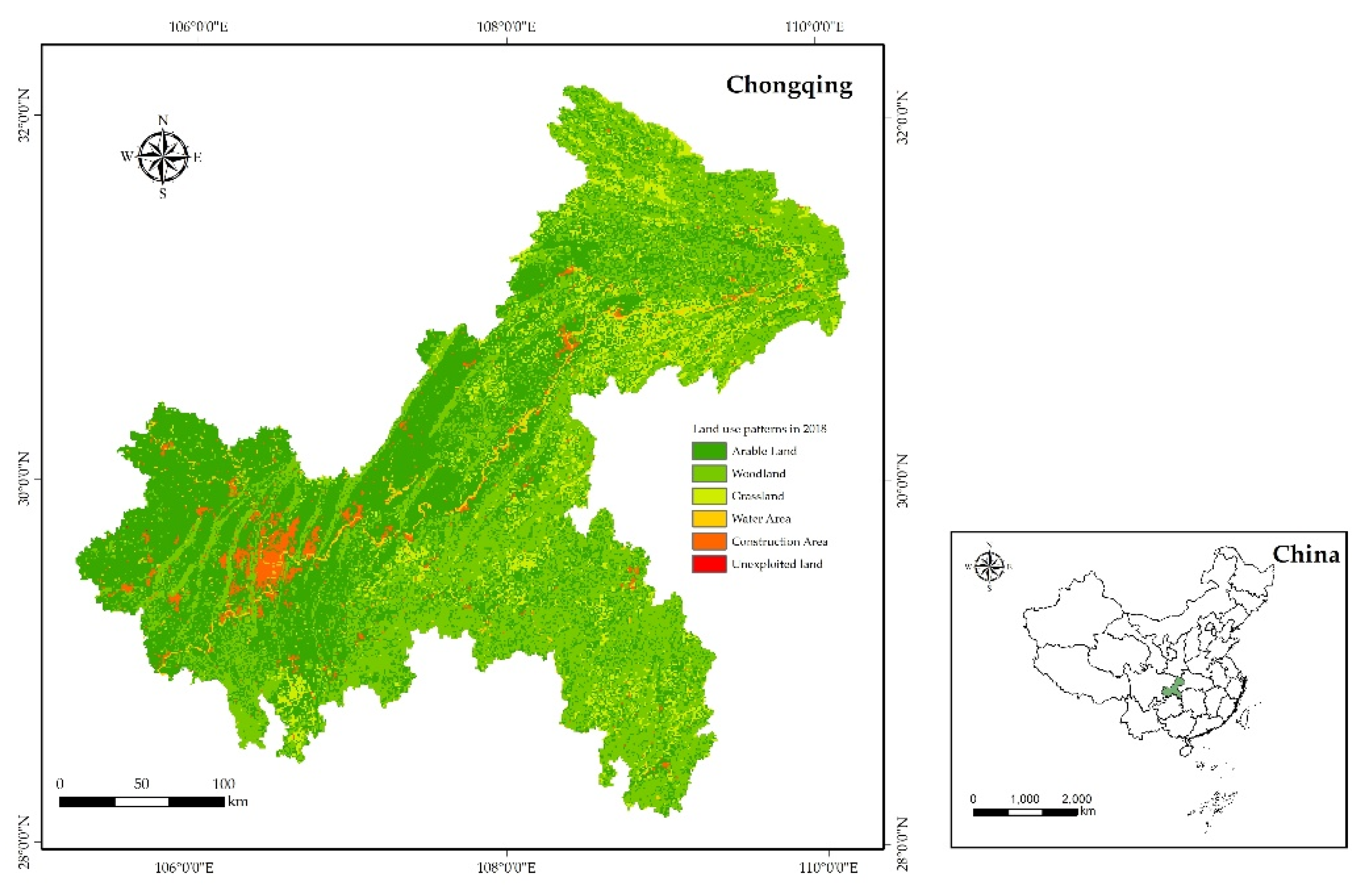
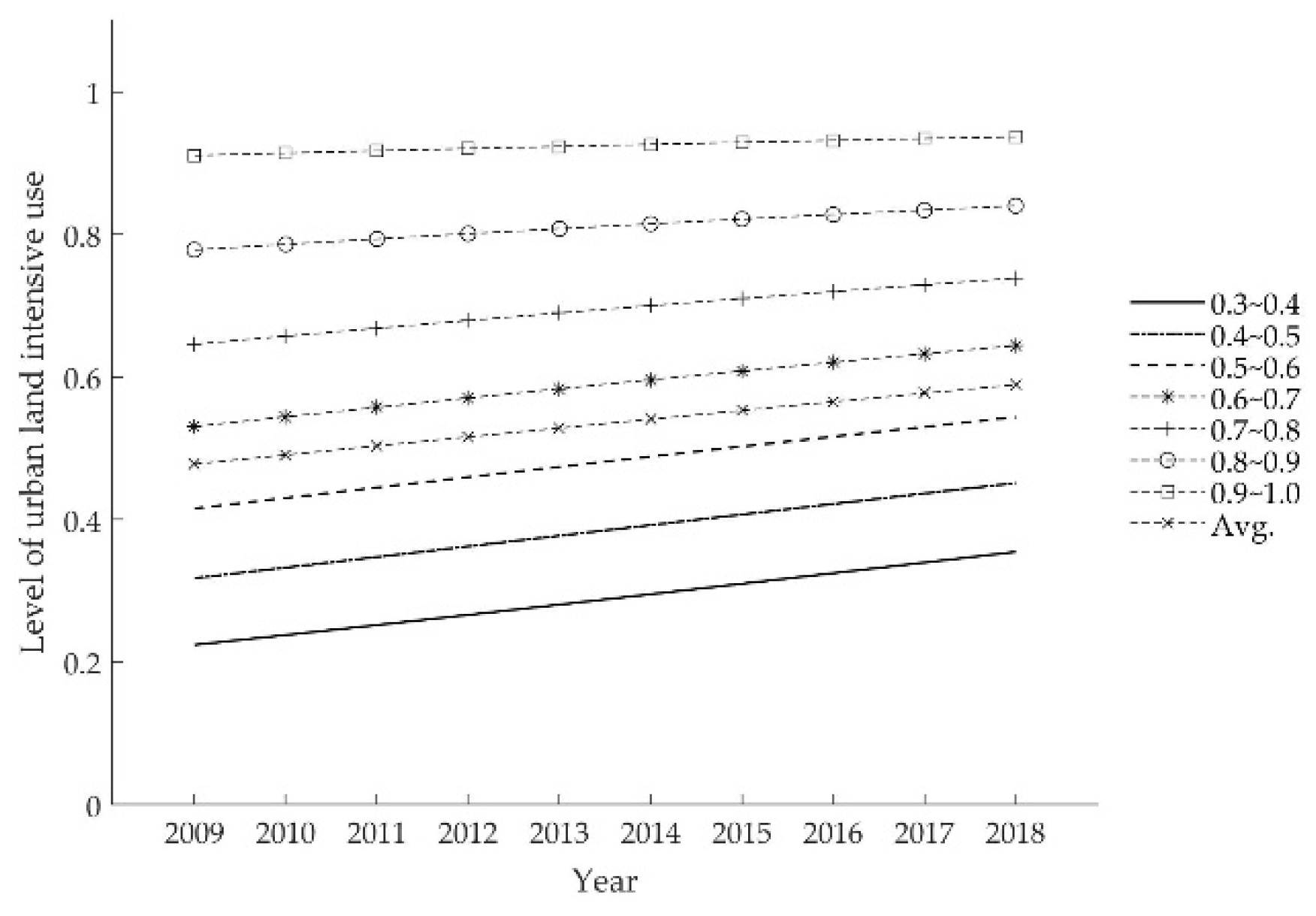
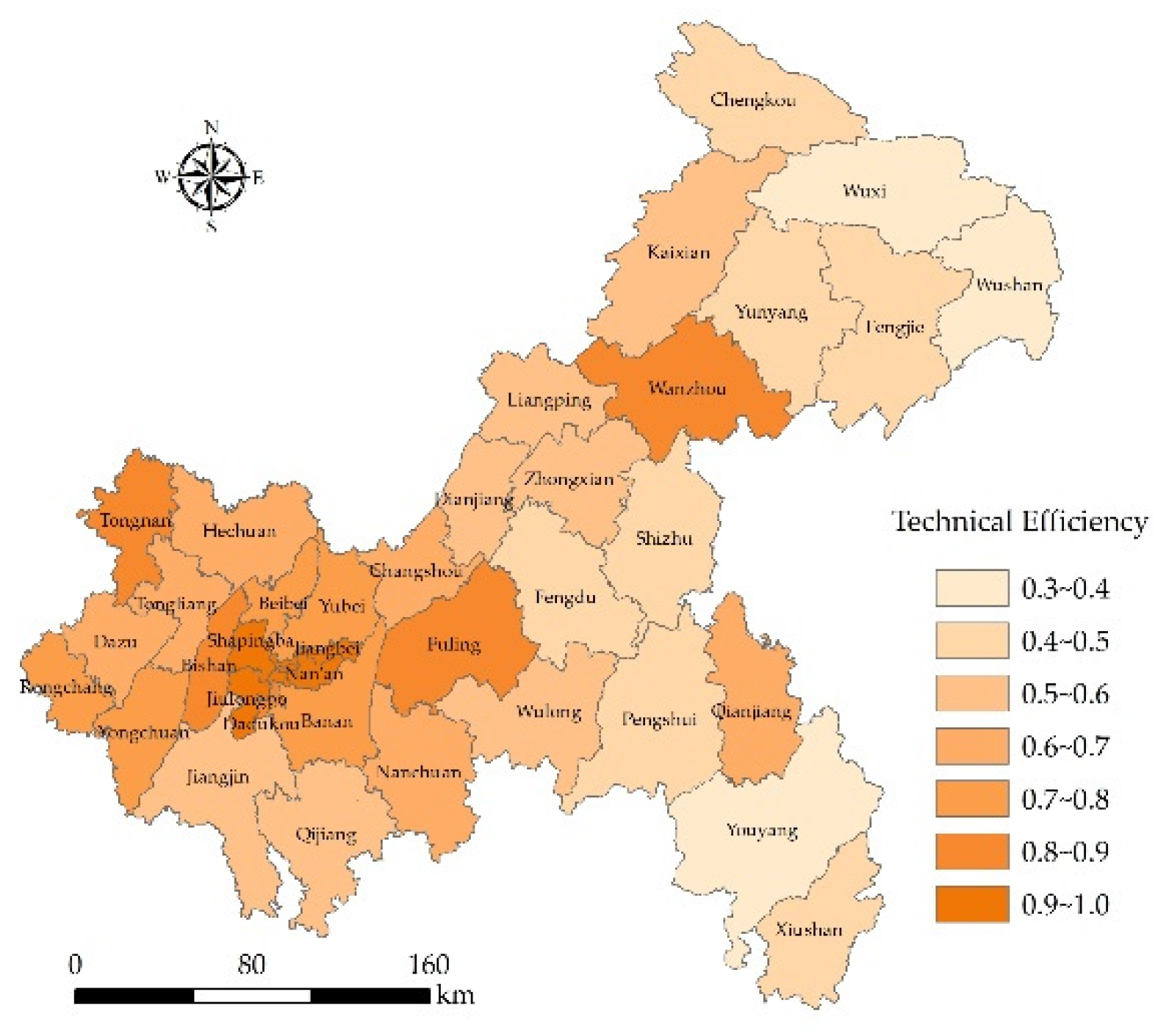


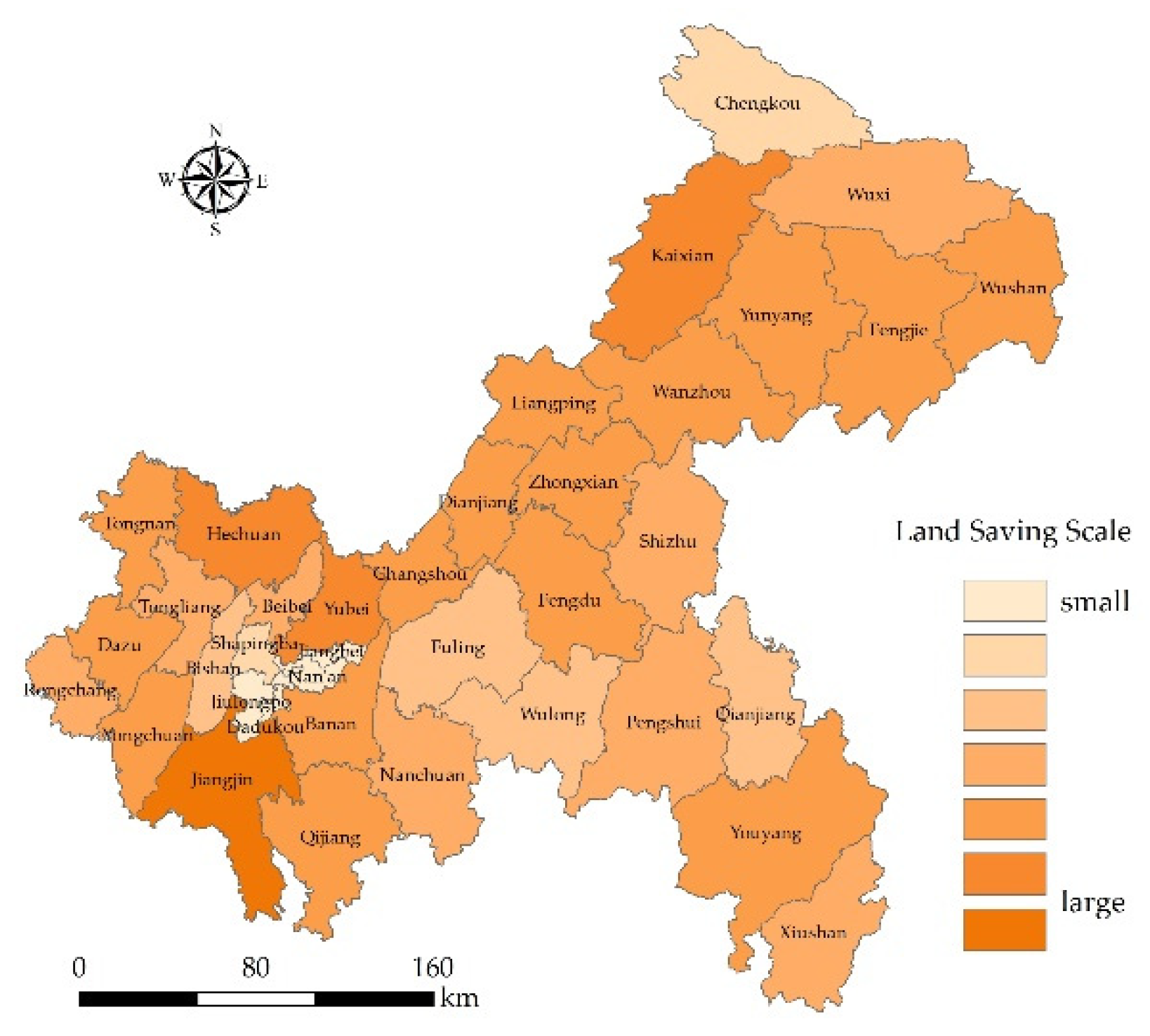
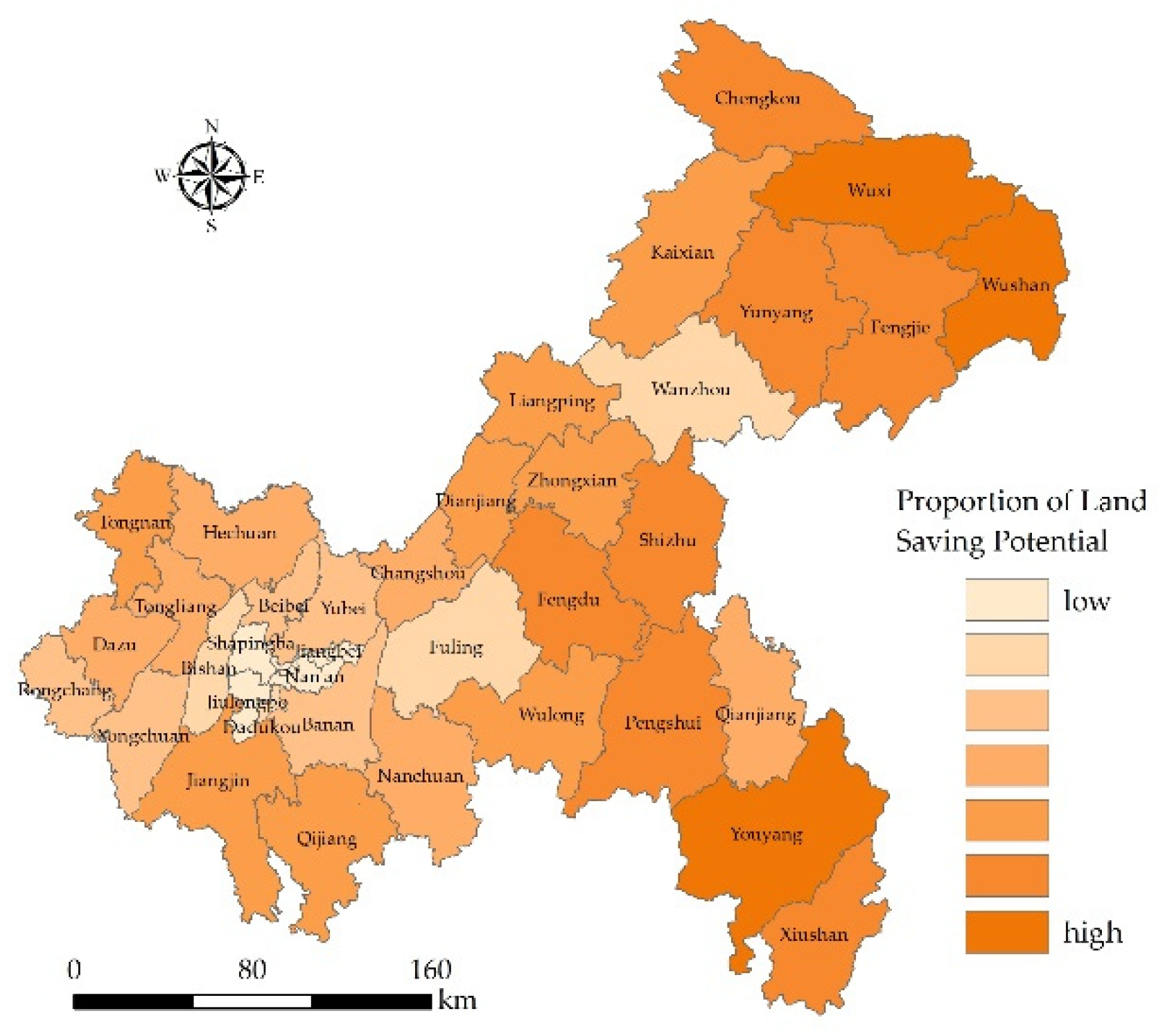
| Variables | Description | Mean | Median | Standard deviation | Minimum | Max |
|---|---|---|---|---|---|---|
| Input-Output | ||||||
| Land area for construction | km2 | 160.01 | 153.79 | 73.51 | 17.94 | 417.08 |
| GDP | in 100 million Yuan | 315.29 | 217.11 | 277.41 | 19.55 | 1235.61 |
| Fixed capital investment | in 100 million Yuan | 295.92 | 238.12 | 209.7 | 29.92 | 1264.53 |
| Water consumption | 10 thousand tons | 11,107.9 | 7581.49 | 14,867.05 | 537 | 98,051 |
| Number of employees | 10 thousand units | 32.64 | 29.23 | 16.62 | 6.17 | 75.68 |
| Influential Factors | ||||||
| Land use structure | % | 13.25 | 9.34 | 13.12 | 1.19 | 77.22 |
| Population density | 10 thousand/km2 | 0.28 | 0.22 | 0.1727 | 0.10 | 4.00 |
| Openness | % | 13.69 | 2.81 | 36.53 | 0.01 | 254.95 |
| Transportation convenience | km/km2 | 18.80 | 15.57 | 13.95 | 3.06 | 90.99 |
| Education expenditure intensity | %/km2 | 32.96 | 29.48 | 18.66 | 4.03 | 113.99 |
| Variables | Model 1 | Model 2 | Model 3 | Model 4 | Model 5 |
|---|---|---|---|---|---|
| Const. | 3.9219(3.26) *** | 3.7454(3.15) *** | 1.5073(7.45) *** | 3.5162(6.34) *** | 2.5939(7.30) *** |
| LnLL | 1.7265(3.57) *** | 1.6115(3.56) *** | 0.2715(6.18) *** | 0.2548(5.89) *** | 1.0909(4.60) *** |
| LnKL | −0.6425(−1.45) | −0.3902(−1.58) | 0.1416(3.89) *** | 0.1316(3.56) *** | 0.1675(4.62) *** |
| LnWL | −0.0257(−0.09) | 0.0210(0.07) | 0.0937(3.46) *** | 0.0989(6.34) *** | 0.0823(3.05) *** |
| t | 0.1327(2.06) ** | 0.0570(7.28) *** | 0.0576(8.39) *** | ||
| LnLL2 | 0.1945(3.41) *** | 0.1942(4.00) *** | 0.1271(3.05) *** | ||
| LnKL2 | −0.0064(−0.08) | −0.0184(−0.54) | |||
| LnWL2 | −0.0049(−0.26) | −0.00004(−0.00) | |||
| t2 | 0.0003(0.17) | ||||
| LnLLLnKL | −0.1385(−1.31) | −0.1305(−2.42) ** | |||
| LnLLLnWL | −0.0409(−0.77) | −0.0106(−0.21) | |||
| LnKLLnWL | 0.0973(1.63) | 0.0344(1.16) | |||
| LnLLt | −0.0043(−0.26) | ||||
| LnKLt | −0.0143(−0.73) | ||||
| LnWLt | −0.0132(−1.46) | ||||
| μ | 0.7882(4.38) *** | 0.6539(4.36) *** | 0.7666(5.79) *** | 2.4003(4.49) *** | 0.5425(4.35) *** |
| η | −0.0075(−0.48) | 0.0264(2.72) *** | 0.0323(4.91) *** | 0.0317(5.10) *** | 0.0408(5.32) *** |
| 0.1971(2.75) *** | 0.1328(3.24) *** | 0.1256(3.73) *** | 0.1244(4.19) *** | 0.1097(3.31) *** | |
| γ | 0.9247(32.17) *** | 0.8839(23.45) *** | 0.869(23.49) *** | 0.869(25.99) *** | 0.853(18.22) *** |
| Log likelihood | 169.4734 | 165.1070 | 153.1337 | 153.1937 | 159.4391 |
| Variables | FE | RE | Variables | One-Step |
|---|---|---|---|---|
| Const. | −0.967 ***(−6.40) | −0.342 ***(−3.72) | Const. | −0.902 ***(−6.78) |
| LnEduEpx | −0.033 **(−2.56) | −0.033 **(−2.44) | LnEduEpx | −0.231 ***(−3.66) |
| LnOpen | 0.006(1.64) | 0.004(1.10) | LnOpen | −0.003(−0.45) |
| LnTransp | −0.092 ***(−5.47) | −0.144 ***(−10.40) | LnTransp | −0.018 **(−2.31) |
| LnLandS | −0.417 ***(−9.49) | −0.265 ***(−9.47) | LnLandS | −0.065 **(−2.25) |
| LnPopD | −0.566 ***(−15.39) | −0.476 ***(−14.44) | LnPopD | −0.255 ***(−4.61) |
| R Square | 0.789 | 0.785 | Log Likelihood | 119.56 |
| Hausman test | choose FE model | |||
| Variables | Main City Metropolitan Area | Northeast Chongqing | Southeast Chongqing |
|---|---|---|---|
| Const. | 1.1642 ***(4.45) | 0.7425 ***(2.75) | −2.9503 ***(−6.32) |
| LnEduEpx | −0.3374 ***(−5.41) | −0.2857 ***(−5.27) | −0.3234 ***(−5.75) |
| LnOpen | −0.0361 *(−1.84) | 0.0014(0.12) | 0.0038(0.32) |
| LnTransp | −0.0566 **(−2.27) | −0.1786 **(−2.14) | −0.0934 **(−2.17) |
| LnLandS | 0.0267(0.71) | −0.1729 ***(−2.59) | −0.2659 **(−2.18) |
| LnPopD | −0.0598 ***(−2.89) | −0.3502 ***(−4.38) | −1.4556 ***(−6.48) |
| Log Likelihood | 58.9379 | 56.0646 | 67.3775 |
Publisher’s Note: MDPI stays neutral with regard to jurisdictional claims in published maps and institutional affiliations. |
© 2020 by the authors. Licensee MDPI, Basel, Switzerland. This article is an open access article distributed under the terms and conditions of the Creative Commons Attribution (CC BY) license (http://creativecommons.org/licenses/by/4.0/).
Share and Cite
Wang, J.; Sun, K.; Ni, J.; Xie, D. Evaluation and Factor Analysis of the Intensive Use of Urban Land Based on Technical Efficiency Measurement—A Case Study of 38 Districts and Counties in Chongqing, China. Sustainability 2020, 12, 8623. https://doi.org/10.3390/su12208623
Wang J, Sun K, Ni J, Xie D. Evaluation and Factor Analysis of the Intensive Use of Urban Land Based on Technical Efficiency Measurement—A Case Study of 38 Districts and Counties in Chongqing, China. Sustainability. 2020; 12(20):8623. https://doi.org/10.3390/su12208623
Chicago/Turabian StyleWang, Jingyi, Kaisi Sun, Jiupai Ni, and Deti Xie. 2020. "Evaluation and Factor Analysis of the Intensive Use of Urban Land Based on Technical Efficiency Measurement—A Case Study of 38 Districts and Counties in Chongqing, China" Sustainability 12, no. 20: 8623. https://doi.org/10.3390/su12208623
APA StyleWang, J., Sun, K., Ni, J., & Xie, D. (2020). Evaluation and Factor Analysis of the Intensive Use of Urban Land Based on Technical Efficiency Measurement—A Case Study of 38 Districts and Counties in Chongqing, China. Sustainability, 12(20), 8623. https://doi.org/10.3390/su12208623




